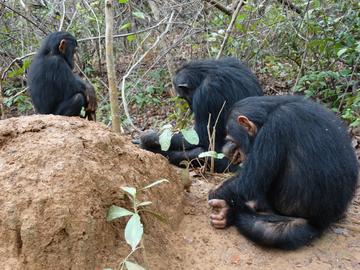
Chimpanzees using plant tools to fish for termites at Gombe Stream National Park, Tanzania (photo credit: Alejandra Pascual-Garrido)
Led by Post-Doctoral Fellow Dr Alejandra Pascual-Garrido, the goal of this project is to document the archaeological signatures left by wild chimpanzees as a result of their use of perishable tools to fish for termites. Alejandra will test whether the use of these technologies by our closest living relatives, the chimpanzees (Pan troglodytes), creates long-lasting recognizable patterns (signatures) of material cultures across the landscape. The human archaeological record includes three-million-years of technological evolution (Harmand et al., 2015). Yet, while the first toolkits almost certainly contained plant-based artefacts, these are absent from the archaeological record until 300,000 years-ago (Thieme, 1997). This poses challenges when reconstructing our technological origins, which therefore continues to be heavily biased towards stone tools (Braun et al., 2019). To learn more about plant-based implements of early humans, we can, as a proxy, study their use by extant non-human apes. This project focuses on two termite-fishing communities of chimpanzees living in west Tanzania (Gombe and Mahale), and their exploitation of termite mounds with woody and grassy plant parts. Utilizing innovative 3D techniques commonly used in the fields of archaeology/paleoanthropology, this research will characterise the signatures chimpanzees leave in the landscape, including source-plant scars, use wear patterns on abandoned implements, tool taphonomy, and the structure of tool use sites. Such ‘archaeology of the perishable’ may allow us to make important inferences about early humans. Currently, our perception of the evolutionary trajectories of human material culture is heavily skewed towards lithic technology – because stones are more durable, but also, because we know little about archaeological signatures that plant-based artefacts may leave in the environment. Unless we first investigate and document such signatures, our perception of the evolutionary trajectories of human material culture will continue to be heavily skewed towards lithic tools. This project is funded by The John Fell Fund, Oxford University, and Oxford International Seed Fund, Oxford University.
This project is a collaboration with: Susana Carvalho, Thomas Püschel and Katarina Almeida-Warren.
Lab students involved in research: Katarina Almeida-Warren.
References:
Braun, D. R., Aldeias, V., Archer, W., Arrowsmith, J. R., Baraki, N., Campisano, C. J., Deino, A. L., Dimaggio, E. N., Dupont-Nivet, G., Engda, B., Feary, D. A., Garello, D. I., Kerfelew, Z., McPherron, S. P., Patterson, D. B., Reeves, J. S., Thompson, J. C., & Reed, K. E. (2019). Earliest known Oldowan artifacts at >2.58 Ma from Ledi-Geraru, Ethiopia, highlight early technological diversity. Proceedings of the National Academy of Sciences of the United States of America, 116(24), 11712. https://doi.org/10.1073/pnas.1820177116
Harmand, S., Jason, E. L., Craig, S. F., Christopher, J. L., Sandrine, P., Arnaud, L., Xavier, B., Rhonda, L. Q., Michel, B., Adrian, A., Nicholas, T., Sophie, C., Guillaume, D., Jean-Philip, B., Louise, L., Richard, A. M., James, D. W., Sammy, L., Christopher, K., Dennis, V. K., & Hélène, R. (2015). 3.3-million-year-old stone tools from Lomekwi 3, West Turkana, Kenya. Nature, 521(7552), 310. https://doi.org/10.1038/nature14464
Thieme, H. (1997). Lower Palaeolithic hunting spears from Germany. Nature, 385(6619), 807. https://doi.org/10.1038/385807a0